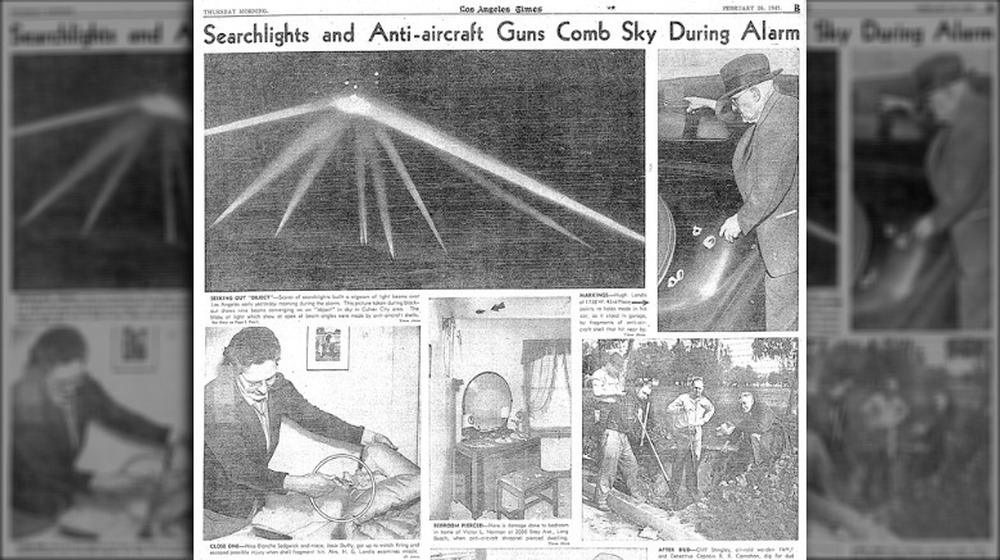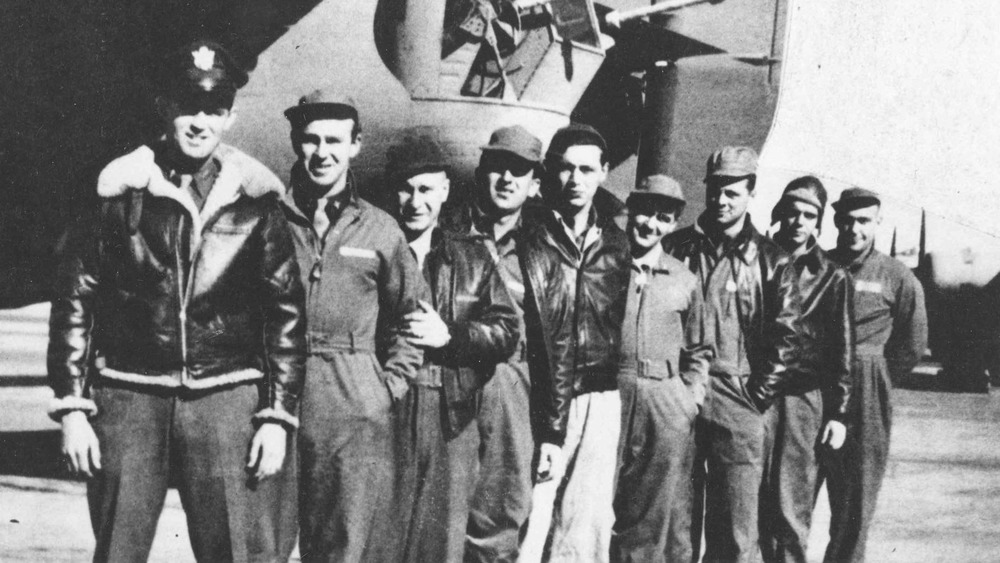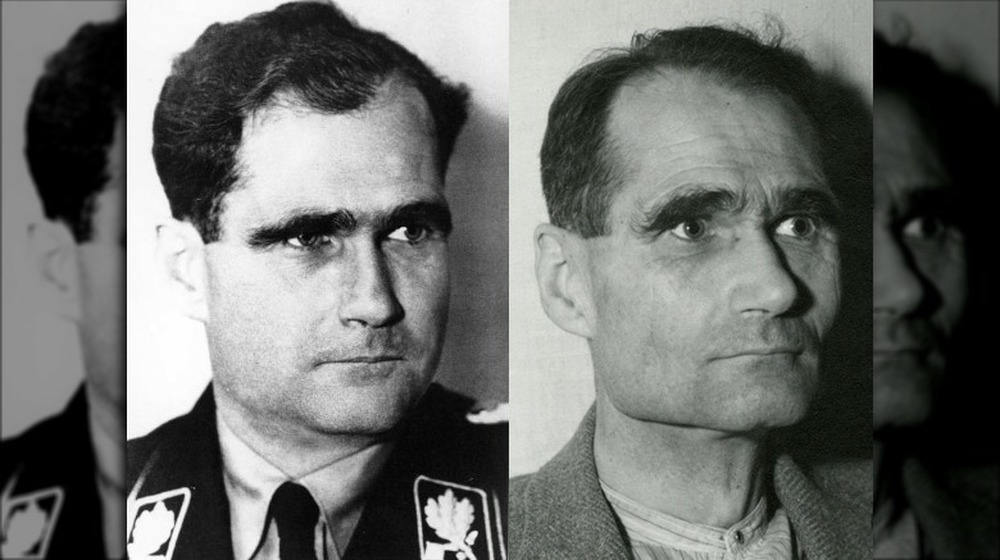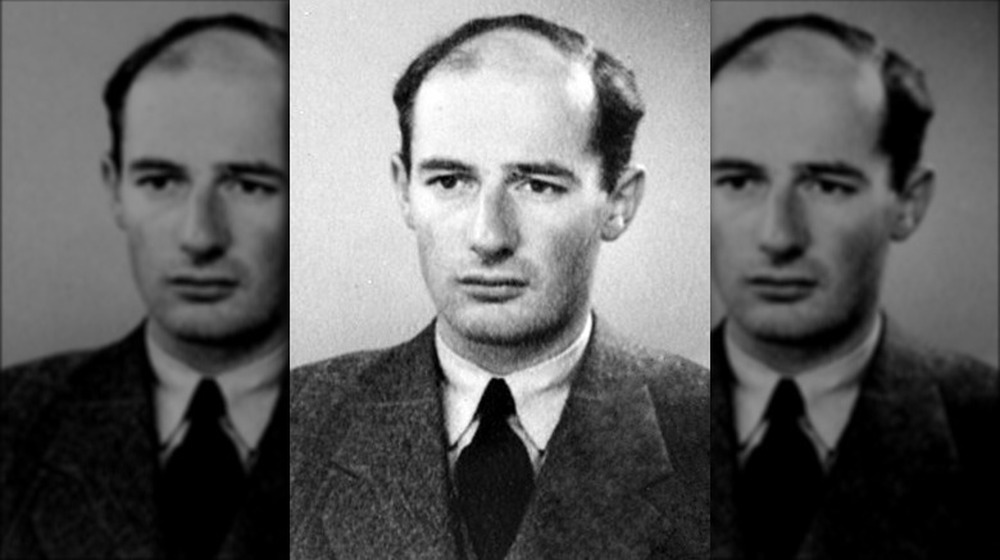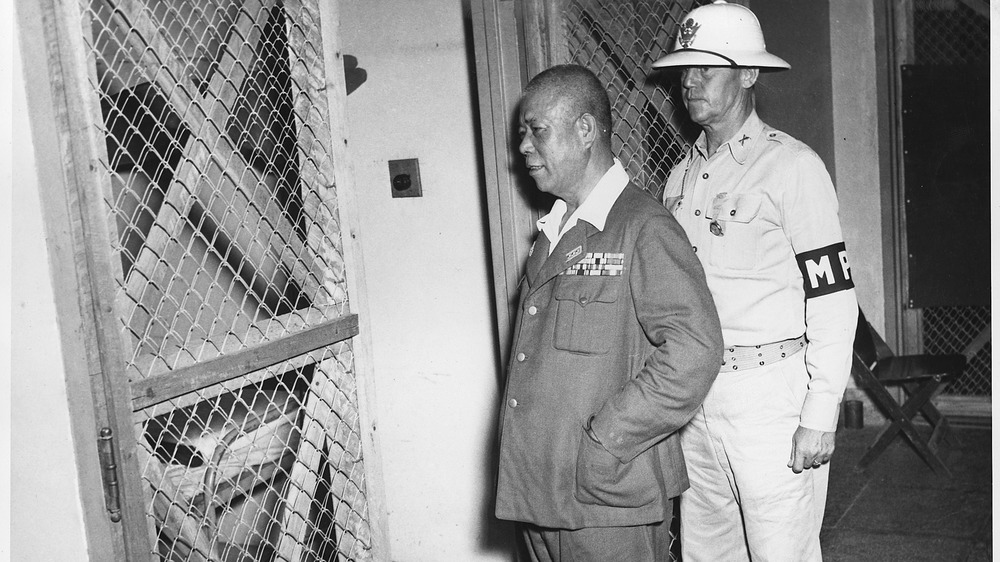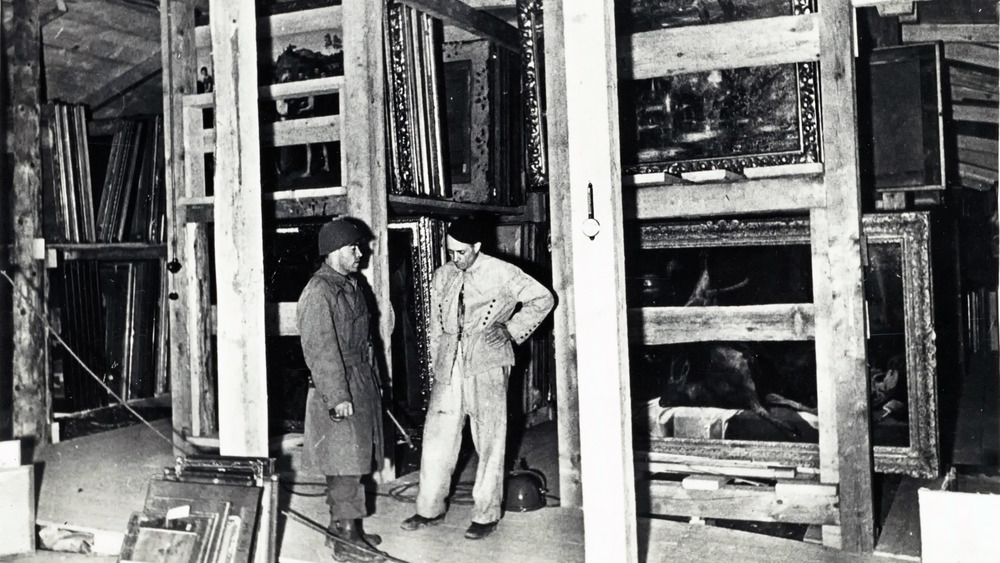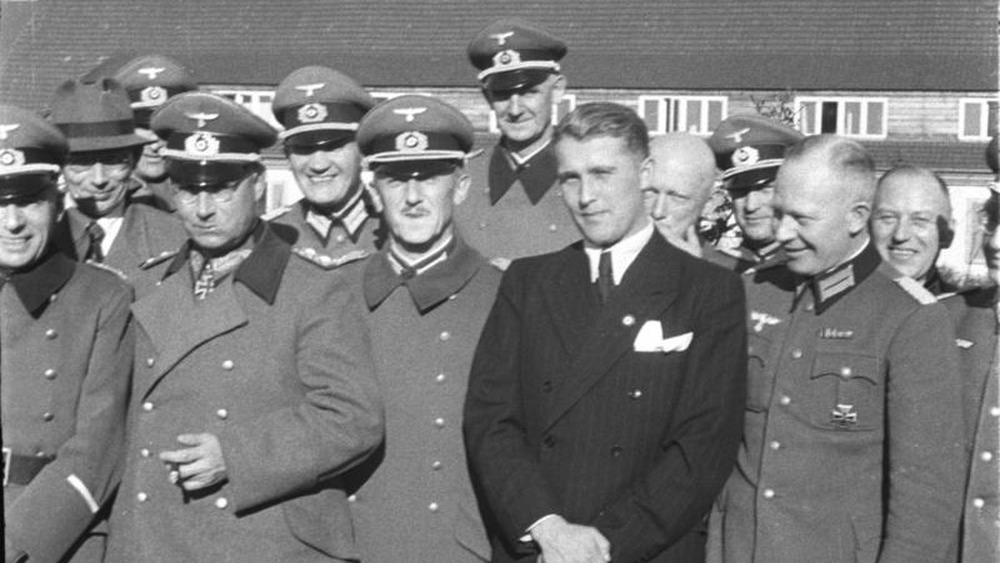The Most Bizarre Unsolved Mysteries Of World War II
World War II was, to say the least, a stressful time. There was a war going on, after all, one that spanned the globe and introduced confusion, death, fear, and general upset seemingly everywhere you went. Yet, since the war ended in 1945, there's been plenty of time to reflect on its importance and tie up any outstanding loose ends from the conflict. Right?
Of course not. Besides the messed up aftermath of the war and its complicated legacy, there are several things from this worldwide conflict that remain pretty mysterious. People from noble war heroes to evil criminals went missing and weren't apprehended for many years, if they were found at all. Immensely valuable art and cultural treasures were looted by the Nazis, who, as the National Archives reports, crammed buildings and hiding places full of plundered goods. Furthermore, the confusion of war meant that many records that would have cleared things right up were lost forever, either in the pre-digital jumble of some state archives or in the firestorm of an air raid.
So, even though more than seven decades have passed since the end of World War II, there are in fact many, many loose ends still floating around today. With some hard work, ingenuity, and not a little bit of luck, there may be answers some of these lingering questions. Then again, some of these puzzles may never be solved. Here are some of the most bizarre unsolved mysteries of World War II.
The Battle of Los Angeles still mystifies people today
The early morning hours of Feb. 25, 1942, were, at least for the people of Los Angeles, some of the most tense of the war. That's when, according to History, military personnel and civilians alike were alerted of a possible airstrike incoming over the city. The night was lit up with search lights sweeping across the sky, while people sat in their blacked-out homes and wondered if Japanese forces had been emboldened by their attack on Pearl Harbor months earlier.
Their fears were surely confirmed when anti-aircraft guns began going off at around 3 a.m. in Santa Monica and, soon enough, the rest of the region. Troops were ordered to fire where some had seen an object floating through the sky. Yet, when the smoke cleared, nothing was to be seen.
According to the The Los Angeles Times, five people died as a result of the "Battle of Los Angeles" — three from a car accident and two from heart attacks. Some buildings were damaged by artillery shells that hadn't detonated in air.
So, what happened? The secretary of the Navy basically chalked it up to nerves, calling the whole thing a false alarm based on bad radar readings. Some witnesses swore they saw enemy airplanes soaring through the sky or may have seen a weather balloon, as History reports. A small number have even claimed that it was all flying saucers, though no one has produced strong evidence one way or another.
The Lady Be Good's crew isn't all accounted for
For years after its 1943 disappearance, no one knew where the B-24D Liberator aircraft known as the Lady Be Good had gone. As far as anyone knew, the Lady and its nine-man crew was returning to a Libyan airfield on April 5, 1943, as Air & Space reports. At least, it was supposed to land there. The plane never made it to the airfield, and its entire crew was presumed lost, perhaps in the Mediterranean Sea.
Fifteen years later, however, the mystery of the Lady Be Good was partially solved, though the exact details of its story remain obscure. Scouts for an engineering company first sighted the plane's wreckage in May 1948 in the desert far south of the coastal airfield. No remains were found with the plane, which still had fresh water and a working radio.
Later evidence found in 1960, including remains of the men, showed that the crew had parachuted out about 16 miles before the plane had crashed. They had likely gotten lost over the vast, nearly featureless desert, and the plane had simply run out fuel. According to Air Force Magazine, the surviving crew attempted to walk north over hundreds of miles, as evidenced by the heartbreaking diary recovered alongside 2nd Lt. Robert F. Toner. How the crew managed to get as far as they did before collapsing, as well as what happened to everyone and why, remains unsolved to this day.
What were the World War II foo fighters?
World War II aircraft crews had plenty to worry about. When they were flying in warzones, they needed to not only avoid wartime hazards like enemy planes and anti-aircraft gunfire but other aviation dangers made all the more complicated by war, like navigation and refueling. Then, there were those weird little lights trailing the planes. Even experienced pilots started to get nervous once these lights, soon nicknamed "foo fighters," began to appear.
According to History, foo fighters were first reported by the Associated Press in 1945, though Allied flight crews had been seeing them at least a year earlier. They often reported seeing balls of light that behaved strangely, typically following the planes and then peeling off or simply disappearing after a matter of minutes. Some of them flashed and seemed to fly in formation, leading a few to believe that they were enemy weapons. Yet, there are no reports that the foo fighters ever attacked or otherwise harmed any aircraft or its occupants. They didn't even register on radar.
If these weird lights weren't German weapons, then what were they? Some blamed "combat fatigue" that plagued hardworking crews, though some rankled at the idea that they were basically hallucinating. Air & Space reports that St. Elmo's fire, a kind of visible electric discharge, doesn't explain the strange movements of the lights. Despite a subsequent CIA investigation in 1953, no one's ever been able to come up with a satisfactory answer.
Why did Rudolf Hess fly to Scotland in the middle of a war?
In 1941, a Scottish farmer found a burning plane and a man standing in his field. The man claimed to be someone named Capt. David Horn, but it soon became clear that was a lie. According to Smithsonian Magazine, "Horn" was actually a Nazi politician named Rudolf Hess, who had flown from Germany to Scotland, evading anti-aircraft artillery and radar detection — though he was sighted — until his crash. But why would such a highly placed person in the Nazi regime leave his position and place himself firmly in the middle of enemy territory?
Hess said he wanted to broker peace between the Nazis and sympathetic British officials, but many remained skeptical. As per the BBC, some believed that Hess was mentally ill. Hess' fanaticism and surprise that he was treated as a prisoner and not a diplomat after his surprising entrance did not help his case.
After his arrest, Hess was quickly imprisoned and must have just as quickly realized that he was in dire straits. He attempted suicide on multiple occasions but survived to be jailed in the Allied-control Spandau Prison until 1987. The 93-year-old Hess died apparently by suicide, though, as The Telegraph reports, many claim that the elderly Hess was deemed inconvenient and killed.
Was there really a Pearl Harbor ghost plane?
A year after the Dec. 7, 1941, attack on Pearl Harbor near Honolulu, Hawaii, locals were frightened to hear another odd plane approaching the area. As History Collection relates, it was Dec. 8, 1942, when Navy radar spotted a single plane on a course from Japan. They quickly scrambled two planes to intercept the newcomer. Navy pilots reported seeing a P-40 fighter, an American craft that was riddled with bullet holes and had ruined landing gear. The pilot waved at them but appeared to be covered in fresh blood. The plane crashed on land soon thereafter, but inspection of the wreckage showed no evidence of a pilot.
Where did the plane come from? Who was its pilot? And, most importantly, can the story be believed?
Skeptoid reports that this gripping story is very likely fictional. It shares strong links with a story written by Robert Lee Scott, Jr., a writer who also served as a pilot during World War II. He later said that he and a fellow pilot had come up with the story to stay entertained during the long days of the war but would have never said anything if they knew it would grow into an urban legend.
Raoul Wallenberg was a World War II hero whose death remains unsolved
Raoul Wallenberg is rightfully considered a hero of World War II. According to Smithsonian Magazine, Wallenberg was a Swedish diplomat who, through his position as deputy secretary at the Swedish Embassy in Budapest, helped thousands of Jewish people flee the Nazi regime via Hungary. Yet, he was apprehended by Soviet officers in early 1945 and then, despite not being accused of any particular crime, disappeared into the Soviet prison system. Some wonder if the Soviets, already wary of their fellow Allies, had suspected him of spying for the Americans. Others think that the Soviet Union wanted to hit Sweden hard for its pro-German policies earlier in the war.
What exactly happened to Wallenberg has never been fully explained, The Guardian reports. The Swedish government didn't do much to follow the case, as they were reluctant to get involved in the Cold War that followed World War II. The Soviets later claimed that Wallenberg had died of a heart attack in Lubyanka on July 17, 1947. Yet, some people even swore that they had crossed paths with Wallenberg as late as the 1980s.
No definitive evidence of his fate has surfaced. Researchers claim that there are still more records out there, but, until Russia releases them, the fate of this heroic diplomat remains unsolved.
Why did German forces abandon a vital Arctic outpost?
Schatzgräber, which translates to "Treasure Hunter," was a station established by Nazis 620 miles from the North Pole. As Popular Mechanics reports, Schatzgräber was strategically situated to interfere with Allied transports moving troops and supplies through the Arctic. It also provided valuable weather information, yet Schatzgräber was abandoned in 1944 when staff grew sick after eating raw polar bear meat.
But why not bring in a new crew to man the strategically important station, perhaps warning them to stay away from polar bear meat? And why didn't anyone reveal the station's existence until well after the war, in 1953? As per History Collection, other explanations for Schatzgräber's existence include the idea that the Nazis were conducting archaeological excavations for mysterious Nordic artifacts.
As Independent.ie relates, many Nazis were obsessed with the occult and a mystical Nordic past that legitimized the regime. Schatzgräber may have been connected to this pseudoscientific urge, making it an awkward fact that may have been concealed under a story of food poisoning.
Yamashita's gold still lures treasure hunters
While the Nazis have been at the heart of many legends about lost World War II treasure, other Axis powers figure into World War II mysteries as well. Take Japanese Gen. Tomoyuki Yamashita. According to Live Science, Yamashita reportedly buried looted treasure somewhere in the Philippines while Japanese forces were occupying the nation. When Yamashita was executed by American forces in 1946, any hope of finding the treasure was dashed. That is, if the treasure is real. Many people have searched for Yamashita's gold in the intervening decades, despite the lack of evidence or records supporting the tale, and have come up with nothing.
That hasn't deterred many. As History reports, the fabled treasure hoard was at the center of a 1988 court case brought against former Philippines President Ferdinand Marcos by Rogelio Roxas. Roxas claimed that he had found part of the hoard, but that Marcos had promptly swooped in and seized the portion of treasure. A court later found in his favor and awarded Roxas a hoard of his own money in 1996. It was too late, however, as Roxas had died in 1993. The official cause of death was tuberculosis, though some believe Roxas had been killed for causing too much trouble over Yamashita's gold and crossing the Marcos family.
What happened to a Nazi train full of looted treasure?
The region of Lower Silesia in modern-day Poland was once considered to be part of Germany, reports The New Yorker. War being what it is, borders have since shifted, and the German occupants of the region fled over the course of World War II. The Polish people who took their place have since uncovered plenty of remnants of their German predecessors and, as the legend goes, there may be more valuable loot still left uncovered. Reports claim that the Nazis, who were fond of looting gold, jewels, and art, hid caches of their plunder throughout the region. One of the most colorful legends claims that there is an entire underground train full of such treasure, buried in a collapsed tunnel somewhere in Poland, most likely near the city of Wroclaw.
Yet, according to the BBC, no one's been able to find this train. It's true that the Nazis did build underground tunnels and that they did indeed steal cultural treasures and valuables from occupied territory. That's been enough evidence for some treasure hunters, including a couple who claim to know just where the train lies in its grave. Yet, no one's been able to definitively prove the existence or location of the Nazi gold train, keeping its story firmly in the realm of mystery.
Where is Russia's glittering Amber Room?
Smithsonian Magazine reports that the Amber Room was indeed an actual room inside the Catherine House, a royal palace in Pushkin, Russia. Previously, it had been in St. Petersburg's Winter House and, before that, Prussia's Charlottenburg Palace. It was a gift from Prussian King Frederick William I to Peter the Great in 1716, after the Russian royal visited Frederick William's place and admired the glorious room. And glorious it was, as the Amber Room was constructed out of tons of amber panels backed with gold. Later renovations added even more glitz and glamour, to the point where many dubbed it the "Eighth Wonder of the World."
When invading Nazi soldiers entered the room in 1941, the panels were nowhere to be seen. Fleeing officials had covered the panels with wallpaper, but it was quickly removed by the Germans. In only a few days, they had shipped the amber panels to Königsberg, Germany (now Kaliningrad, Russia).
This is where the trail peters out. According to The Guardian, the disassembled Amber Room was last spotted in Königsberg before disappearing out of the record. Some suspect that it's now at the bottom of the Baltic Sea, after a steamer was sunk near there in 1945. Others think that the panels were destroyed in air raids or may still be hidden in some forgotten storage space elsewhere. Russian artisans have since recreated the room in the Catherine Palace with modern materials.
Some are still searching for human fossils lost in World War II
While some treasure-based mysteries of World War II are understandably focused on the glamor of things like gold and priceless works of art, there are some treasures that don't fit the mold. And, while they may not be immediately eye-catching in the same way as some priceless gemstones, they're just as — if not more so — important.
One such treasure are the fossils of "Peking Man." As per New Scientist, this is a set of about 200 fossils of Homo erectus, an early human ancestor. They were excavated in China's Zhoukoudian cave during the 1920s and 1930s. When the approach of World War II and Japanese troops halted the excavation, China carefully packed the fossils and sent them to the United States, where officials hoped they would be safe. Yet, Peking Man never made it to the U.S. Somewhere between China and the U.S. Marine ship that was supposed to ferry them off to America, the fossils disappeared.
Now, more than 75 years after the end of the war, the location of the Peking Man fossils remains a mystery. It's possible that the two crates containing the fossils were buried at the Marine base, reports Smithsonian Magazine, though no one's yet excavated the area where the base once stood. That's because the most likely location, assuming the bones are there at all, is beneath a paved parking lot.
Ratlines made for mysterious Nazi escapes
Towards the end of the war and in its aftermath, numerous Nazis and fascists left Europe to escape the rash of imprisonments, executions, and other punishments that were coming their way. Some high-placed intellectuals, like Nazi rocket scientist Werner von Braun, were quietly ferried over the United States via Operation Paperclip, which relocated some 1,600 Germans scientists and their family members.
Even more Nazis were found to be missing in Europe, sometimes later popping up in places like South America many years later. Adolf Eichmann was captured by the Mossad, Israel's intelligence agency, in Argentina in 1960, History reports. How could some of these criminals have gotten so far and evaded capture for so long, with some escaping punishment entirely?
The escape networks used by the Nazis were eventually known as "ratlines," though it's still not clear who was involved, how the ratlines ran, and how much everyone knew about the affair. According to DW, it's possible that Vatican officials aided German criminals as they fled. And places like Argentina, which proved to be one of the most popular destinations, seemed to be full of government officials who would conveniently look the other way. It's even possible that Pope Pius XII knew more than he was letting on, though, without a confessional document uncovered in the Vatican archives, the truth of his involvement continues to be mystery.

